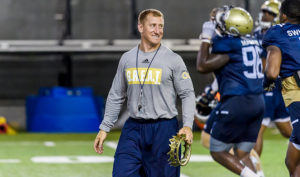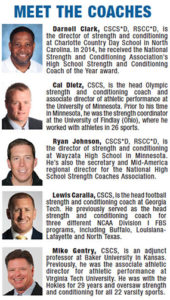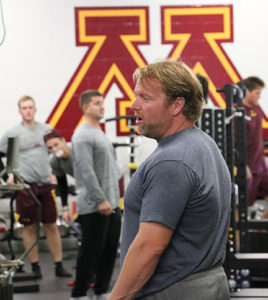Oct 25, 2019Strength coaches roundtable: Using analytics in training
In our 2019 strength coaches roundtable, we look at the ways information and analytics influence how athletes train.

Strength and conditioning has become a data-driven enterprise. Innovative devices and software help coaches understand their athletes’ limits, monitor progress and assist in recovery. They’ve ultimately reinvented the way coaches train their athletes.
In this year’s strength coaches roundtable, we ask some of the best trainers in the business about the data they use in their programs and the impact it has made with their athletes. Roundtable participants include Darnell Clark, Cal Dietz, Ryan Johnson, Lewis Caralla and Mike Gentry. Learn more about them on page 26.
What are the main areas related to athlete performance in which you collect data?
Caralla: Our GPS Catapult System tracks all of our team runs in the offseason. We try to match a week’s load as close as we can to a week of practice. We can see their top speed, and if they are coasting on some of our max effort work.
In addition to the GPS, we test a variety of things to measure the athlete’s performance: 225 bench max, pushups, pullups, vertical jump, broad jump, 10-yard sprint, L-drill, pro-agility shuttle, arm and neck measurement, body fat percentage, and we make sure we take their pictures before and after the offseason.
Johnson: I primarily collect performance data. We measure squat, clean, bench, vertical, broad jump, 20-yard sprint, 40- yard sprint and pro agility.
 We have created formulas based on these results to evaluate athletes on athleticism as well as strength and power. The categories are: Trojan Strength Rating (TSR), which is a pound-for-pound strength rating that’s factored off of strength to mass index; Power Factor (PF), derived by a formula that factors vertical jump and body weight; and Performance Rating (PR), which is a combination of the TSR and PF. We track athletes throughout their high school experience. The PR has become a valuable tool in predicting athletic success without factoring in sport skill.
We have created formulas based on these results to evaluate athletes on athleticism as well as strength and power. The categories are: Trojan Strength Rating (TSR), which is a pound-for-pound strength rating that’s factored off of strength to mass index; Power Factor (PF), derived by a formula that factors vertical jump and body weight; and Performance Rating (PR), which is a combination of the TSR and PF. We track athletes throughout their high school experience. The PR has become a valuable tool in predicting athletic success without factoring in sport skill.
Dietz: I collect data on general athletic movements like running and jumping. To me, those are foundational to see if you’re getting improvement, because if you’re not improving in those areas then you may not be improving athleticism.
Clark: The main areas in which we collect data are daily wellness questionnaires, functional movement screens and strength evaluation/daily recording. We evaluate our teams on 40s, 5-10-5, vertical jump, broad jump, kneeling med ball toss and some type of conditioning test.
Gentry: Height, bodyweight and body composition; Flexibility (sit and reach); absolute strength; speed strength; clean variations, push jerk; speed (40-yard sprint); acceleration (10-yard sprint); explosive power; standing vertical jump; agility (20-yard shuttle); and conditioning (110-yard shuttles).
What tools do you use for collecting this data (i.e. products, devices, techniques)?
Caralla: GPS, BOD POD, NordBord and Fusionetics, which is a self-survey injury prevention system.
Johnson: The biggest tool I have is our summer program: the Trojan Power Program. We train the athletes for seven to eight weeks in the summer, and then we have the Trojan Olympics. This last week is always a highlight of the summer. The top three athletes in grades 10 to 12, male and female, go on our display board in the weight room. We don’t post all-time records on this board, but instead list the yearly winners of the summer program. We do keep records of each summer, but the only way to make the board is to train with us all summer.
Dietz: Over the years, I’ve used HRV, questionnaires, various biofeedback devices, blood pressure, heart rate monitors, velocity based training devices, muscle lab, GPS, and many variations of those.
Clark: We use Excel spreadsheets, FMS kits, vertical jump pads and athletic management software.
Gentry: We use the BOD POD, Power Systems Sit and Reach Box, handheld timing, Brower Timing Systems and Vertec.
Do you use force plates to collect data and, if so, what data do you collect through this tool?
Caralla: We have not. I’ve had experience using force plates though. We based our entire summer program off the results of the mid-thigh pull on a force plate — what athlete needed certain things more than others, like strength-speed or speed-strength. You could tell that from the force plate by seeing their rate-of-force development. We had a speed-strength group, a strength-speed group and a balanced group. I thought it went very well and guys seemed to improve in areas where they drastically needed it.
Dietz: I used to about two decades ago, but I’ve found force plates are pretty limited in regard to predicting training protocols. I think force plates are an excellent source for return-to-play to confirm the athlete has the ability to perform without a bilateral deficit.
The optimal time to use them is maybe a screening tool, when you first get your hands on the athlete and then during the return-to-play protocol. When an athlete first walks in and you find that there’s a problem, such as the ability to absorb force, I was able to fix it with triphasic training concepts. I found that if I just did triphasic training twice a year, we took care of the majority of the problems, unless there was a past history of injury.
I think people are putting so much value in the force plates to predict training models and, in my opinion, are hoping that the fraction-of-a-second sequence can give you an understanding of an athlete’s needs across the 40-yard dash, which is impossible. We have to realize that a short movement jump cannot predict training protocols in all dynamics of sports.
Clark: We don’t have a true force plate, but we do have a jumping pad that collects vertical jump, repeated jumps and other metrics. From this, we get our lower body explosion and repeatable explosion.
Gentry: No, we did not use force plates in training or testing athletes at Virginia Tech during my tenure.
How do you use data as it relates to team strength/conditioning programs, customizing individual programs, or with recovery and wellness?
Johnson: This depends on each specific coach or program. I have some coaches who use this as motivation within our summer program. For example, our offensive line may have a goal of everyone squatting 400 lbs. Our basketball program may want everyone to improve their agility scores. It really depends on the goals of each sport coach for that season. Obviously, we want everyone to get stronger.
Clark: Those tools allow us to set up protocols on team warmups based on FMS scores and team injury trends. They also help us set up customized percentages based on one-rep max test; wellness reports, which allow us to make decisions about recovery protocols; track team and individual workout data; and compare team to team, year to year, player to player, and position to position.
Gentry: I am a big believer in the testing and evaluation of parameters that you, the coach, feel are important to your athlete’s physical development. That means the physical development that ultimately affects their athletic performance (i.e. jump higher and run faster).
It’s my opinion that most people are more engaged when they know the “score” of their performances. We want to be successful, and being able to track and personally evaluate our strengths and weaknesses gives our training relevancy and energy.
As a coach, I want to see any trends that might be connected to changes in training protocol that most often are revealed through testing. Failure to test and study the results of testing often leaves us without needed answers. The results of physical testing often leads us coaches to adjust training for the individual athletes and, equally as important, it may motivate the athlete to make changes in lifestyle or training effort that will elevate his performance.
Does the use of the data vary between in-season and offseason programs?
Caralla: The use of data mainly turns to the GPS to monitor fatigue during practice and to keep us fresh before a game. In-season, it’s trying to stay in an optimal range of player loads compared to the offseason, where we try to push them more so they’re prepared.

Johnson: This is primarily offseason data collection for all of our programs, as it occurs in the summer. We do reference the data as each team trains throughout the year, as it serves as a point of reference to the athletes.
Dietz: I would use more data in the offseason to push the limits of my athletes. I feel most people don’t see much variation between in-season and offseason training loads. But, I feel in the offseason in a very controlled setting, you can stress athletes’ very specific stressors to help them survive the stress during the season.
I’m very fortunate to work with coaches who manage their in-season practice stress very well and really have to worry about modifications of stress and, if I do it, usually the athletes fault due to lifestyle, sleep habits, nutrition or other variables.
Clark: Most of our data collection comes prior to preseason training and at the completion of preseason training.
Gentry: One of the major values of testing and evaluation is the ability to use the results to more safely prescribe training loads and volume during the season. Knowing how much weight on the bar should provide enough resistance while allowing good bar speed is important. Having the ability to measure bar speed is very important in the prescription phase of physically training explosive athletes. We used Tendo Units to measure bar speed.
Training methods are beyond the scope of this round table, but having more information about an athlete’s capabilities should help you more safely prescribe his workouts. I have learned that it’s better to err on the safe side of injury.
Do you use data to evaluate functional movement vs. strength/conditioning improvement?
Caralla: We evaluate basic movements like squatting, lunging and stabilization, and then make adjustments based on limiting factors. For example, if a guy can’t squat with proper technique, we will use multiple variations of exercises that work the same muscle groups but take a load off the back — goblet squats, trap bar dead lift, belt squat or leg press, to name a few. We would work on his technique before and after the lift to make sure he continued to progress.
Johnson: We focus on dynamic warmups and functional movement, as it’s integrated in all of our workouts. We do not record this data, but we do evaluate the athletes on an individual basis and discuss this with the coaches.
Dietz: I use data to make sure my programs are progressing my athletes. I do not waste time with movements that are not important to the sport. I’ve seen a paradigm shift of people believing slow, controlled movements can always tell me about high performers or injury. I find this not to be the case. If this is true, a majority of high performers would have the ability to do very sound functional movements, and we all know that’s not necessarily so.
Clark: Yes, we use the FMS to determine and customize our teams’ daily pillar prep (injury preventions protocols). In some cases, an athlete is given individual pillar prep protocols if they perform under the desired standard.
Gentry: No, we didn’t test and compile data of our football player’s functional movement during my tenure at Virginia Tech. We did use the FMS with many of our Olympic sports. I believe that it could have been beneficial to regularly test and evaluate our players using the FMS and prescribing appropriate corrective exercises. I would encourage high school and collegiate strength and conditioning coaches to consider this. It makes sense to me.
Do you use data, or any other strategies, as a means for motivating athletes during training?
Caralla: Yes. We have a record for fastest man in Atlanta based off the Catapult numbers at workouts and practice. We have a top-10 board of mph speed that’s constantly changing. During team runs, we can see if every person is giving their own 90% of max effort. We tell them if the whole team hits 90% effort of their max for X amount of reps, they’re done. That motivates them to give great effort at the end of a run.
Johnson: The Trojan Olympics and the board in our weight room have become a large motivational factor for our programs. The first is that athletes have to do our program to test and be on display. This gets our participation numbers up. Once in the program, kids will train very hard to score well, win the Trojan Olympics and get on the board. Their names are on display for a year, and they go down into our record books that we update each year. We keep all of the data in Excel, and we update our top-20 performances each year. Kids can compare themselves to some of our famous alumni.
» ALSO SEE: 2018 strength coaches roundtable: Pushing athletes in training without going too far
Dietz: I think the single most effective strategy is biofeedback. If you can get feedback from a bar, speed on velocity based training or a contact mat when jumping, I see my athletes improve.
Clark: By using percentages during strength workouts that are based on an individual’s testing results, it customizes a team workout to the individual’s capabilities. This is motivating to our students, because it create a competition with yourself and not others.
Gentry: I always felt that a good athletic strength and conditioning program served several purposes. Each athlete should measurably improve physically through training, while the team intangibles of cohesion and accountability are improved through the crucible of training. Creating an atmosphere of expectation of effort and commitment is essential for success; this is the job of a coach. Validation of training methods comes from testing and the athletes experiencing success. For many athletes, winning begins in the weight room; accomplishment here builds the physical tools and confidence needed to win in actual competition. A strength coach’s visual and verbal enthusiasm lets the players know that it’s important to him and soon transfers to the team.
Creating award opportunities that foster peer recognition for strength and conditioning accomplishments will pay dividends. It’s very important that the athlete’s sport coach is aware and supportive of their athlete’s improvements. Coach Frank Beamer would often adjust the depth chart based on a player’s great success in the offseason program or great disappointments in the offseason program. It was noticed.
Is this kind of data important to sport coaches, and do you communicate with them about individual athletes?
Caralla: Yes. This data gives us a great understanding of where the athlete is daily on workload. We know his normal, his high and his low. The coaches meet with their players daily about efforts given just based off the data.
Johnson: This data/feedback is important to our coaches. They want to see results and encourage their athletes to understand the value of working hard. We understand that athletes can have great numbers and results in the program, but that’s not a guarantee of playing time or performance.
 It does help us with individual athletes, as some have injuries or areas of concern that we need to address. If an athlete is not able to back squat because of something like mobility issues, we do not force exercises or test them. We make adaptations and work on other factors.
It does help us with individual athletes, as some have injuries or areas of concern that we need to address. If an athlete is not able to back squat because of something like mobility issues, we do not force exercises or test them. We make adaptations and work on other factors.
Dietz: I would only communicate levels of fatigue, how certain things seem to fatigue our athletes the most, and what to be aware of. For example, I noticed that if we lose and we have to travel back home, our athletes were a lot more stressed than if we won at home. They were less stressed if they won a series of away games and traveled home than if they had lost. It’s just educating coaches on the type of stressors and things that need to be considered important.
Clark: We give coaches 24/7 access to all of their teams’ data. We encourage them to use it for team selection, technical and tactical decisions, recovery protocols, motivation, team competition, and evaluation. Some coaches use it frequently, and others never use it, but it’s always available.
Has the availability of data/analytics changed the way your athletes are involved with their own strength training/wellness? Does it make them more engaged?
Caralla: Yes. All the players compete with the GPS units. It makes them go harder in practice because they know everything they’re doing is monitored. It gives them a daily goal to hit, which is very internally driven. They get ranked by position every day based on workload, and they don’t want to be last. It’s been great.
Johnson: I understand there are a lot of other ways to collect and integrate technology and software platforms to collect much more detailed data. I like a lot of the stuff that’s out there, but I haven’t quite found the right one for us yet. I’m trying out some different data collection tools this upcoming school year.
What I have done is to utilize some athlete readiness questionnaires that’s starting to make a difference. We use Google docs to have the kids keep track of sleep, nutrition, stress and injuries. That’s really starting to get the kids to think about what they’re doing outside of the program, and how those factors play a major role in their development.
Dietz: Not directly to the data. I think it’s important on the delivery and the coach educational process to teach them what the numbers mean.
Clark: Yes. Our wellness questions are important to us. The primary goal of our daily wellness questionnaires is not for us to track the athletes’ information as coaches. We want to connect the athlete to their daily choices to performance — inside the classroom, and out on the field.
Have you encountered any obstacles/difficulties with using data, or is there any caution you would give to other strength coaches who are beginning to use it in their programs?
Caralla: Just be careful how you use the data. Sometimes you use it for effort only, but just remember to consider the harder they work, the harder they need to recover to repeat that same effort the next day.
Johnson: We built a great new facility within the last three years, and the Wi-Fi is not very good. That makes it hard to utilize. The other thing is money. It costs money to do this, and we had to outfit our room with equipment before we could start spending money on these technologies.
Dietz: No. just make sure all of your devices are approved by your organization in regards to HIPPA.
Clark: Start small and perfect your collection and usage methods before going to another layer of data collection. You also want to make sure the juice is worth the squeeze. Make sure you’re collecting data to support the choices that matter. I wouldn’t suggest collecting data for the sake of collecting data.
If I’m a strength coach at any level who wants to make my program more data-based, what advice would you give me?
Caralla: Track your percentages in the weight room. Track your volume during your conditioning. Give the kids a great chance by making the conditioning workload similar to the practice workload they will soon experience. Monitor progressions and de-loads throughout the month. Don’t make drastic spikes in workload, and be careful with your players.
Johnson: I would suggest to use technology as a tool to make what you already do more efficient. I would not suggest using data just because the coach across town is doing it. Establish your why of using data prior to just signing up and compromising your program for the sake of being able to tell parents, athletes and coaches that you’re using it because all the good programs are using it. And, if you do start collecting data and using it, you had better understand how to use whatever system you choose.
Dietz: Use your money wisely, visit people who may have various technologies, and truly see if they’re using it. You would hate to invest in something that sounds cool but you have no ability and capacity to completely test. My No. 1 go to is timing gates to see how fast my athletes are progressing.
Clark: Figure out what data is most beneficial to your program and start there.


